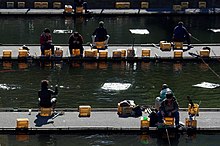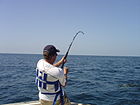
Teochew cuisine, also known as Chiuchow cuisine, Chaozhou cuisine or Teo-swa cuisine, originated from the Chaoshan region in the eastern part of China's Guangdong Province, which includes the cities of Chaozhou, Shantou and Jieyang. Teochew cuisine bears more similarities to that of Fujian cuisine, particularly Southern Min cuisine, due to the similarity of Teochew's and Fujian's culture, language, and their geographic proximity to each other. However, Teochew cuisine is also influenced by Cantonese cuisine in its style and technique.

Tempura is a typical Japanese dish that usually consists of seafood and vegetables that have been coated in a thin batter and deep fried. Tempura has its origins dating back to the 16th century, when Portuguese Jesuits brought the Western-style cooking method of coating foods with flour and frying, via Nanban trade.
Merfolk, Mercreatures, Mermen or Merpeople are legendary water-dwelling, human-like beings. They are attested in folklore and mythology throughout the ages in various parts of the world. Merfolk, Merpeople, or simply Mer refers to humanoid creatures that live in deep waters like Mermaids, Sirens, Cecaelia etc.

A typhoon shelter is a shelter for fishing boats during typhoons. These facilities are often found in Hong Kong.
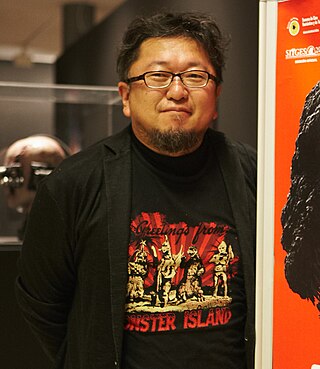
Shinji Higuchi is a Japanese filmmaker. Known for his tokusatsu blockbusters, Higuchi is considered one of Japan's leading filmmakers of the 21st century.

The shrimp fishery is a major global industry, with more than 3.4 million tons caught per year, chiefly in Asia. Rates of bycatch are unusually high for shrimp fishing, with the capture of sea turtles being especially contentious.

Fish balls are the balls made from fish paste which are then boiled or deep-fried. Similar in composition to fishcake, fish balls are often made from fish mince or surimi, salt, and a culinary binder such as tapioca flour, corn, or potato starch.

Macrobrachium rosenbergii, also known as the giant river prawn or giant freshwater prawn, is a commercially important species of palaemonid freshwater prawn. It is found throughout the tropical and subtropical areas of the Indo-Pacific region, from India to Southeast Asia and Northern Australia. The giant freshwater prawn has also been introduced to parts of Africa, Thailand, China, Japan, New Zealand, the Americas, and the Caribbean. It is one of the biggest freshwater prawns in the world, and is widely cultivated in several countries for food. While M. rosenbergii is considered a freshwater species, the larval stage of the animal depends on estuarine brackish water. Once the individual shrimp has grown beyond the planktonic stage and becomes a juvenile, it migrants from the estuary and lives entirely in fresh water.

Shrimp or prawn dishes are often prepared by frying, especially deep frying. There are several styles.
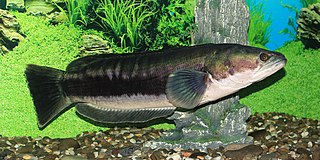
Channa micropeltes, giant snakehead, giant mudfish or toman harimau, is among the largest species in the family Channidae, capable of growing to 1.3 m (4.3 ft) in length and a weight of 20 kg (44 lb). It is native to the fresh waters of Southeast Asia, but has also been introduced elsewhere and is considered invasive in Taiwan. Other names include shol machh in Bengali, red snakehead, redline snakehead, and ikan toman.

Acetes is a genus of small shrimp that resemble krill, which is native to the western and central Indo-Pacific, the Atlantic coast of the Americas, Pacific coast of South America and inland waters of South America. Although most are from marine or estuarine habitats, the South American A. paraguayensis is a fresh water species. Several of its species are important for the production of shrimp paste in Southeast Asia, including A. japonicus, which is the world's most heavily fished species of wild shrimp or prawn in terms of total tonnage and represent the majority of non-human animals killed for food in terms of number of individuals.
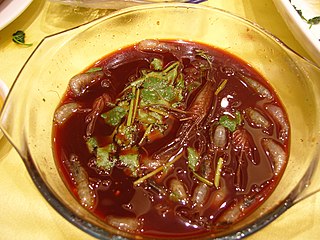
Drunken shrimp, also known as drunken prawns, is a popular dish in parts of China based on freshwater shrimp that are sometimes eaten cooked or raw. The shrimp are immersed in liquor to make consumption easier, thus the name "drunken". Different parts of China have different recipes for the dish. For example, the shrimp are sometimes soaked in alcohol and then cooked in boiling water rather than served live, and in other recipes cooked shrimp are marinated in alcohol after they are boiled. Another version is based on shrimp that are submerged in a bowl of rice wine. The rice wine forces the shrimp to expel their wastes; the shrimp are then eaten, generally after their movement has ceased.
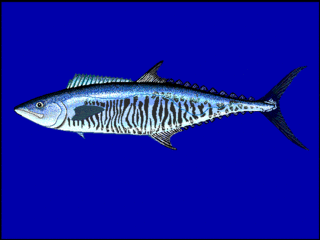
The narrow-barred Spanish mackerel is a mackerel of the family Scombridae found in a wide-ranging area in Southeast Asia, but as far west as the east coast of Africa and from the Middle East and along the northern coastal areas of the Indian Ocean, and as far east as the South West Pacific Ocean.

A shrimp is a crustacean with an elongated body and a primarily swimming mode of locomotion – typically belonging to the Caridea or Dendrobranchiata of the order Decapoda, although some crustaceans outside of this order are also referred to as "shrimp".

Fishing is important to the national economy of Vanuatu. It is the main source of income for many in the islands and Vanuatu's biggest export. According to 2009 figures, approximately 77% of households in Vanuatu are involved in fishing activity. According to 2005 figures, Vanuatu caught 151,080 fish in that year, with frozen fish accounted for half of Vanuatu's commodity exports.

Lucensosergia lucens is a species of shrimp popularly known as the sakura shrimp or sakura ebi. The translucent pink shrimp derives its name from sakura, the Japanese word for the cherry blossom. The species grows to about 4–5 cm and lives primarily in Suruga Bay in Shizuoka Prefecture, Japan, where it is caught to be eaten. It is also caught in Taiwan.

Har cheong gai, is a Singaporean fried chicken dish, consisting of fried chicken wings in a batter with fermented shrimp paste.

Sumikko Gurashi (すみっコぐらし) is a set of fictional characters produced by the Japanese company San-X. The name directly translates to "life in the corner". The main Sumikko characters are Shirokuma, a polar bear who dislikes the cold, Penguin? who is unsure of being a penguin, Tonkatsu, a piece of leftover pork cutlet, Neko, a timid and anxious cat, and Tokage, a dinosaur who pretends to be a lizard. Minor Minikko characters include Furoshiki, a polka dot furoshiki cloth, Zassou, a weed with a positive attitude, and Tapioca, multi-colored leftover tapioca pearls. The characters were created by Yuri Yokomizo, a graphic designer working for San-X, and the first products were released in 2012. Their main inspiration was the feeling of comfort when one is near a corner, and they were based on Yokomizo's notebook doodles when she was a student. A wealth of merchandise, such as stationery, plush toys, and clothing, is sold. Books, mobile apps, and video games based on the franchise have also been produced. Three animated films with Sumikko Gurashi were released in 2019, 2021, and 2023.

Shinojima (篠島) is an inhabited island in Mikawa Bay on the Pacific coast of Japan. The island is administered as part of the town of Minamichita in Aichi Prefecture, Japan. As of 2015, the island's population was 1,653 inhabitants in 622 households. All of the island is within the borders of the Mikawa-wan Quasi-National Park.

